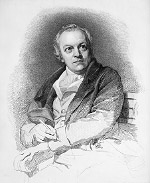|
|

William Blake, frontispiece
to Blair's Grave, 1808
(NGV. 44a)
布莱克在那个时代被视为异类,但他的许多观念却为现代读者所接受。当该诗创作出来时,人们认为一个诗人对野生动物感兴趣事件非常奇怪的事儿。当时的人们并不能像今天的读者那样,可以看到有关野生动物的纪录片。那时人人们只能从动物园或马戏团里看到那些珍奇的动物。但即使如此,老虎仍然是难得一见,它的形象可能偶尔会出现在地毯或者针织品上(这后来在 19世纪变得非常普遍)。正如今天的人们把老虎视为野生动物的象征,布莱克也把这种动物看作一种象征,但问题是它究竟象征什么呢?我们或许可以从他的另一首诗《羊羔》或者原诗中的第5节中找到一些线索。布莱克想象的奇异使得那些过于简单的解释都难以自圆其说。我们不能十分肯定布莱克究竟想通过老虎这个形象向我们传达些什么,但他笔下的老虎所表现出的自然界之王者风范和异常强大的力量是不言而喻的。
布莱克将此诗的题目命名为《老虎》,这让人立刻就注意到这是一种奇特的或者与众不同的生物。诗歌开始的那两句脍炙人口的双行押韵句表达了昏暗的“黑夜的森林”与那让人印象深刻的“燃烧着的煌煌的火光”的老虎的色彩形成的对比。布莱克仿佛用一个画家的眼睛在描绘。
接下来的问题直指“老虎”本身,虽然读者关于老虎象征意义的理解问题不亚于此。人们通常把前者称为“修辞学”上的问题(这个词常用于正式的书面语,它的希腊文为rhetoric),因为这些问题通常都不会有确切的答案。然而那些需要回答的问题本身同样模棱两可。例如需要回答的第一个问题可能是“上帝的”(神手或天眼),但与其说布莱克要问“是谁的(力量)”(Whose?)还不如说是要问“是哪种(力量)”(What kind of?)。
我们无法想象是哪个人或者哪一个种东西,竟然有如此强大的力量创造出这样一种生物。关于老虎是被神手或天眼所造的观念与《圣经·创世纪》里的故事又有关:上帝在伊甸园中行走而挪亚被关在他的方舟里。布莱克在这里再次用一双画家和雕刻师的眼睛去观察老虎,它那“威武堂堂”却也错综复杂的斑纹。那是一个细腻敏感的人类艺术家对一件神圣而伟大的艺术杰作所发出的由衷的敬畏。

布莱克在诗里问到老虎眼中的火焰源自何处?仿佛是某个艺高胆大的人抓住这团火焰,将其放在老虎的眼中。(在希腊神话中,普罗米修斯从天神那里盗取火种教给了人类)诗人为老虎内在那股复杂的驱动力而惊叹,为让那样的心脏跳动的力量所惊奇。诗人思索着这样的动物,它的大脑是如何被创造出来的“是怎样的槌……在怎样的熔炉中……是怎样的铁砧?”
倒数第二节将我们带回到《圣经·创世纪》的创造故事中:在创造万物那六天中的每一天,上帝都看这一切“甚好”。上帝在这里被赋予一个凡人的具像,他正在为自己的杰作而欢欣雀跃,然而布莱克却感到困惑:老虎真的是上帝所造吗?如果是,那么同样出自上帝之手,为何老虎和羊羔会如此大相径庭?带着诗歌最开始的问题,全诗恰到好处地结束了。诗人把还是的动词“能”(Could)换成了结尾时的“胆敢”(Dare),使它读起来更加有力。
这首诗与其说探究的是“老虎是什么”,不如说诗人仿佛像一个动物学家或者一个亲眼目睹的观察者那样欲要告诉我们:“老虎的真正意义是什么”。布莱克把老虎想象成上帝创造力的杰作:它有着令人惊骇的壮美,力量和活力。
附原文:
Blake was regarded in his time as very strange, but many of his ideas make sense to the modern reader. When this poem was written it was most unusual for writers to show interest in wild animals. People did not have access to wildlife documentaries on television, as we do today: exotic animals might be seen in circuses and zoos, but tigers would be a rarity, perhaps turning up stuffed or as rugs (this was to become very common in the 19th century). Just as today the tiger is a symbol of (endangered) wildlife, so for Blake, the animal is important as a symbol - but of what? One clue is to be found in the comparison with The Lamb (see the next poem, and the fifth stanza of this one). Blake's images defy simple explanation: we cannot be certain what he wants us to think the tiger represents, but something of the majesty and power of God's creation in the natural world seems to be present.
Blake's spelling in the title (The Tyger) at once suggests the exotic or alien quality of the beast. The memorable opening couplet (pair of rhyming lines) points to the contrast of the dark "forest of the night" (which suggests an unknown and hostile place) and the intense "burning" brightness of the tiger's colouring: Blake writes here with a painter's eye.
The questions that follow are directed at the tiger, though they are as much questions for the reader. They are of the kind sometimes called rhetorical (frequently used in public speaking, rhetoric in Greek) because no answer is given. However, these are questions to which the answer is far from obvious. For example, the answer to the first question might be "God's" ("immortal hand or eye"), but Blake is asking not so much "whose?" as "what kind of?" We are challenged to imagine someone or something so powerful as to be able to create this animal. The idea that the tiger is made by someone with hands and eyes suggests the stories in the Biblical book of Genesis, where God walks in the Garden of Eden and shuts Noah in his ark. It is again the painter and engraver who observes the complexity of the tiger's markings in their "fearful symmetry". The sensitive human artist is awe-struck by the divine artistry.
Blake asks where the fire in the tiger's eyes originates. It is as if some utterly daring person has seized this fire and given it to the tiger (as, in Greek myth, Prometheus stole fire from the gods and gave it to men). The poet is amazed at the complexity of the tiger's inner workings ("the sinews of thy heart"), at the greater power that set the heart beating, and wonders how the animal's brain was forged: "What the hammer...in what furnace...what the anvil?"
The penultimate (last but one) stanza takes us back to Genesis and the creation story there: on each of the six days (He rested on the seventh) God looked at His work and "saw that it was good". God is represented as being pleased with His creation, but Blake wonders whether this can be true of the tiger. If so, it is not easy to see how the same creator should have made The Lamb. The poem appropriately ends, apparently with the same question with which it started, but the change of verb from "could" to "dare" makes it even more forceful.
This poem is not so much about the tiger as it really is, or as a zoologist might present it to us; it is the Tyger, as it appears to the eye of the beholder. Blake imagines the tiger as the embodiment of God's power in creation: the animal is terrifying in its beauty, strength, complexity and vitality.
出处:http://www.universalteacher.org.uk/poetry/blake.htm |
|